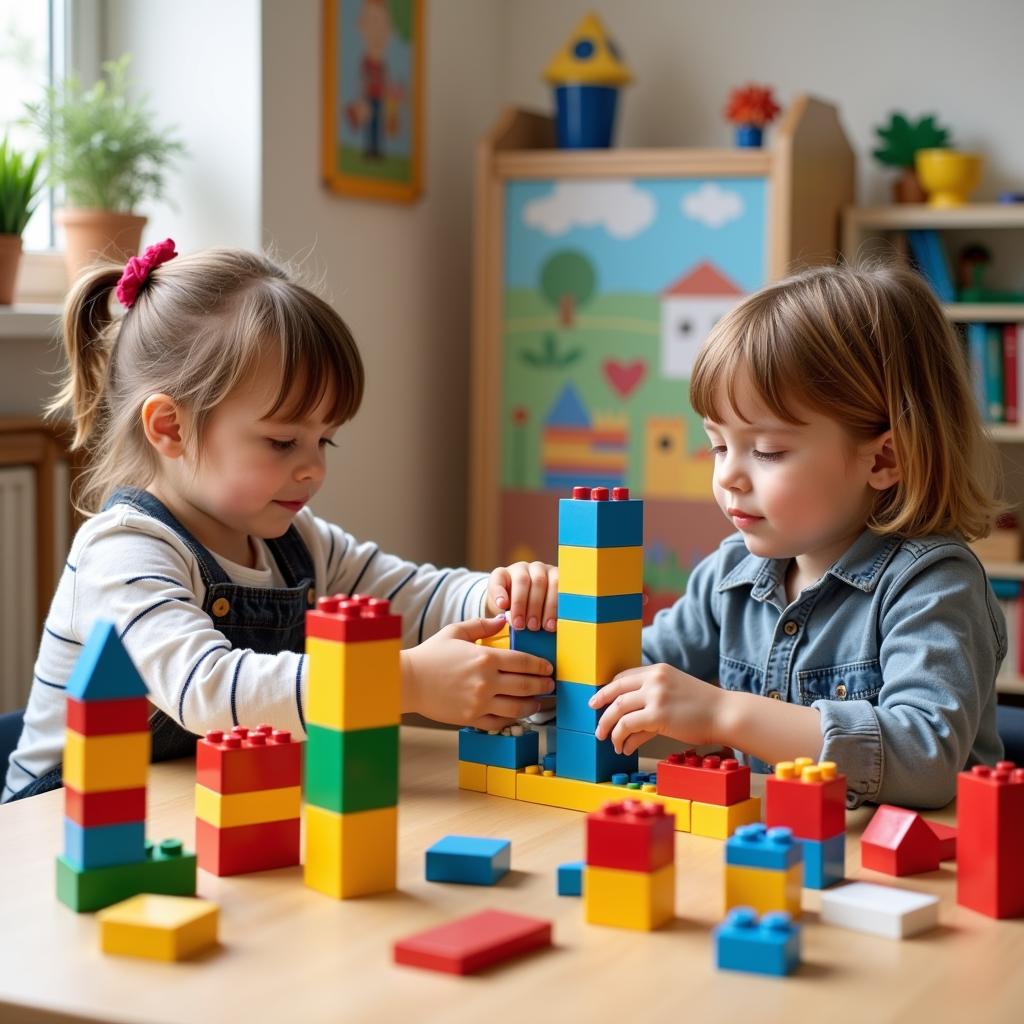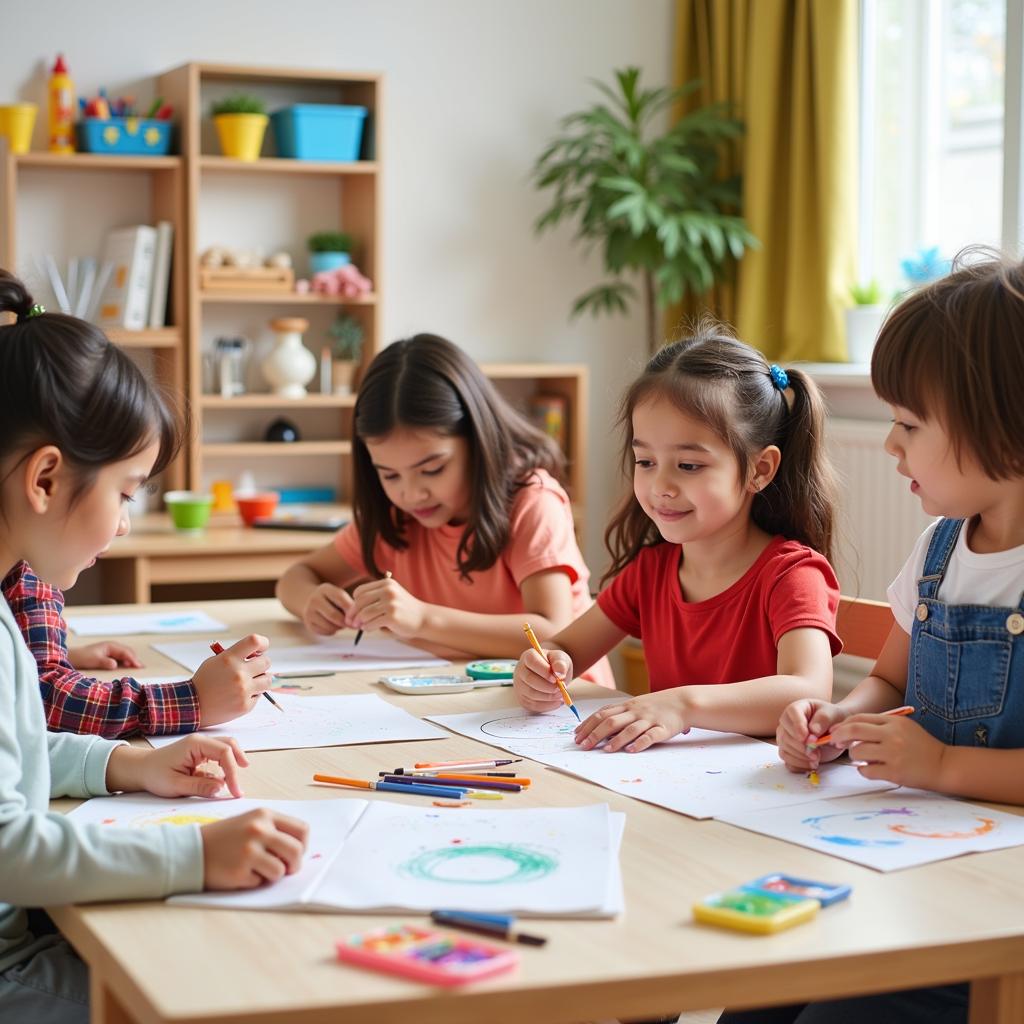“A learning corner is a miniature world where children can freely explore, learn, and develop themselves.” – Ms. Hoa, teacher at Hoa Sen Kindergarten.
Are you looking to create an ideal learning space for preschoolers? Or are you interested in learning how to arrange traditional corners in kindergarten? Let’s explore with TUỔI THƠ the secrets to creating a truly unique and engaging “learning corner” for young children!
The Significance of Traditional Corners in Kindergarten
“Learning corners are an indispensable part of early childhood education.” – Ms. Thu, teacher at Bong Sen Kindergarten.
Traditional learning corners are designated spaces in the classroom designed to allow children to access and experience learning activities in traditional ways, suitable for their psychology and abilities.
Creating a Space That Belongs to Children
Traditional learning corners are places for children to freely explore, learn, and develop basic life skills through play. This space allows children to engage with traditional folk games, helping them cultivate patience, concentration, and creativity.
Nurturing a Love for National Culture
Traditional learning corners are designed based on traditional cultural features of the nation, helping children access beautiful cultural values and contribute to preserving and promoting national cultural identity.
Promoting Holistic Development for Children
Traditional learning corners help children develop holistically in terms of physical, mental, and intellectual aspects. Children develop motor skills, communication skills, problem-solving skills, and creative skills through fun and learning activities in the corner.
Common Traditional Corners in Kindergarten
Construction Corner
 Kindergarten construction corner
Kindergarten construction corner
The construction corner is often decorated with toys such as:
- Lego: Colorful plastic blocks of various shapes and sizes help children develop thinking, creativity, and dexterity.
- Wooden blocks: Traditional wooden blocks help children develop hand-eye coordination, problem-solving skills, and creativity.
- Construction with natural materials: Wood, bamboo, bamboo shoots, clay… are familiar materials that help children develop creativity, dexterity, and closeness to nature.
Art Corner
 Kindergarten art corner
Kindergarten art corner
The art corner is often decorated with:
- Blackboard, colored chalk: Traditional tools that help children unleash their creativity with simple drawings, poems, and stories they create themselves.
- Paper, paints, crayons, colored pencils: Help children unleash their creativity with colorful paintings and simple artworks.
- Art toys: Toys such as playdough, origami paper, beads… help children develop thinking, creativity, and dexterity.
Science Corner
A kindergarten science corner with children exploring natural materials
The science corner is often decorated with:
- Collection of natural materials: Leaves, flowers, seashells, stones, bark… help children explore the natural world, develop observation skills, and learn about nature.
- Simple experiment tools: Test tubes, glass cups, water bottles, stirrers… help children perform simple experiments and develop scientific thinking.
- Books and scientific materials suitable for age: Help children access scientific knowledge in an easy-to-understand and engaging way.
How to Arrange Traditional Corners Effectively
“Arranging learning corners needs to be suitable for children’s psychology and abilities, creating safety and excitement for children.” – Ms. Liên, teacher at Sao Mai Kindergarten.
Define the Objectives of Each Corner
Before arranging, it is necessary to clearly define the objectives of each learning corner to choose appropriate toys, materials, and decorations.
Create a Spacious and Safe Environment
Learning corners need to be arranged neatly, airy, and safe for children. Use bright colors, arrange toys suitable for children’s height, and ensure corners are rounded.
Create Attraction for Learning Corners
Decorate learning corners with beautiful pictures, engaging stories, and fun games to attract children’s attention. Use recycled materials and DIY toys to create unique and creative learning corners.
Regularly Change Content and Arrangement
Regularly change the content, arrangement, toys, and materials in the learning corners to create novelty and attraction for children. This helps children avoid boredom and always be excited about learning activities.
Advice for Teachers
“Learning corners are places where children can freely express themselves, create conditions and encourage children to participate in activities.” – Ms. Lan, teacher at Hoa Hong Kindergarten.
- Observe children and listen to their ideas to choose appropriate toys, materials, and arrangements.
- Create space for children to freely explore, learn, and create in the learning corners.
- Encourage children to participate in activities in the corner, helping them become confident and develop holistically.
- Do not force children into a certain mold, let them freely explore, learn, and create in their own way.
Conclusion
Traditional learning corners play an important role in early childhood education. Arranging traditional learning corners in a reasonable, creative, and child-appropriate way will help children access knowledge, skills, and culture in the most natural and effective way. Let’s join TUỔI THƠ in creating fun and meaningful learning spaces for preschoolers!